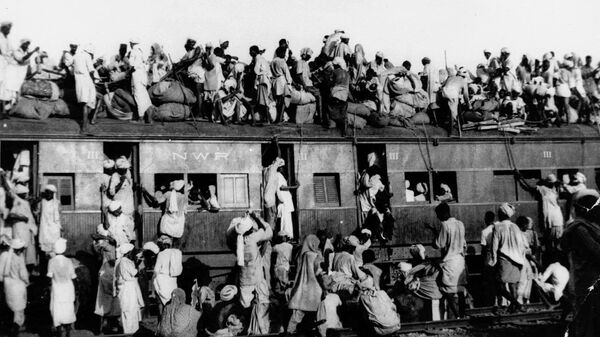The partition of the Indian subcontinent resulted in the death of more than a million people and about 14 million people were uprooted, and “forced” to leave their ancestral lands. While political leaders and freedom fighters rejoiced at the departure of the British, many Hindus, Sikhs in Pakistan and Muslims in India found themselves to be on the wrong side of the border with the announcement of the Radcliffe Award on 17 August 1947.
The Radcliffe Award was the boundary line, the outcome of an official plan announced by the last viceroy of British India Lord Mountbatten, that divided British India into two separate sovereign states - India and Pakistan. As per the plan, the provinces of Bengal and Punjab were to be divided into two parts, one comprising Muslim majority districts and the other Hindu and Sikh majority ones.
Lord Mountbatten had convinced Muslim League leader Muhammad Ali Jinnah and Indian Congress leader Jawaharlal Nehru to agree to split Bengal and Punjab but the intricate borders between the two countries were yet to be decided.
Appointment of Radcliffe
An Oxford graduate and practicing lawyer, Sir Cyril Radcliffe, with next to no knowledge of the Indian subcontinent, was entrusted with the task to draw the final boundary line. It was reasoned by the British that Radcliffe was given the job "because any person who knew the country would certainly be disqualified as being prejudiced by either side".
Radcliffe came to India on 8 July 1947; the Indian Independence Act was passed by the UK Parliament and came into force on 18 July, leaving Radcliffe with a few weeks to do the job with 15 August as his deadline.
Historian and professor Kapil Kumar, citing official documents, says: “It was Radcliffe who decided that he will finish the boundary work in six weeks. The time given initially was two-and-a-half-years for all the settlements, finances, trade, military etc. But suddenly they (the British) decided they will leave on 15 August, 1947, and that is how this man started cutting his time short, just sat in the office and drew a line”.
However, Dominique Lapierre and Larry Collins’ Freedom At Midnight mentions Radcliffe as saying: “Jinnah, Nehru and Patel told me that they wanted a line before or on 15th August. So I drew them a line”. It has repeatedly been claimed that Radcliffe wasn’t given enough time for the partition work.
Kumar goes on to highlight India and Pakistan’s dominion status under the British and dismiss the claims of a shortage of time. “What India got on 15 August was not independence but dominion status. In 1948, when C. Rajagopalachari was appointed as governor general after Mountbatten went away, Nehru writes a letter to the King of England on behalf of his cabinet seeking his permission to appoint Rajagopalachari as the governor general of India and in all documents which are addressed, they are addressed as premier of Indian dominion and premier of Pakistan dominion” he says.
The Indian independence bill draft, the Congress resolution of the draft sent to British said that make it clear that India has been made a dominion and Pakistan has been made a separate dominion, he adds.
1947 :: Movement of Refugees During Partition of India
— indianhistorypics (@IndiaHistorypic) August 13, 2020
(Photo Division ) pic.twitter.com/q6sTZc5qvh
Until January 26, 1950, India functioned as a British dominion, where unelected Indian nationalist leaders were administered oaths in the name of the King-Emperor by a British Viceroy. The period of three years from 1947 to 1950 were crucial for India as it was during this time that leaders were to fix borders, exchange populations, write a constitution and undergo the legal processes of decolonization.
Kumar underlines: “Why he (Radcliffe) was assigned the job is not understandable. But the crucial question is why Congress agreed to this kind of line-drawing by Radcliffe, who didn’t know about the region. Why was no protest was made over it? Why was it accepted?
Among other things divided between the new dominions were cash, debt, financial reserves like gold bars, offices, furniture, books etc., which were divided in an equally bizarre ways. Some tables sent from government offices from India to Pakistan did not accompany chairs & vice versa. Police-Band instruments were not spared, as drums were given to India and flutes to Pakistan and so on.
Could Delayed Boundary Stop the Bloodshed of Partition?
The celebration of independence has overshadowed the horror of partition, wherein men killed their own women and children in the name of honour. The partition of India resulted in one of the worst refugee crises. As per Indian government estimates, 83,000 women were abused and abducted during the migration; rehabilitation workers place these figures even higher.
The communal violence saw sexualized violence against women, which has not been recorded by either side officially which makes tracing the facts on refugee crisis even more difficult. It is only historians and scholars in the present day who are working on oral histories and testimonies to record the brutality.
“Bloodshed is not related to boundary lines. It was happening earlier also, Jinnah had called for direct action day in 1946, followed by Calcutta riots. It is not just the division aspect but because the way the government left, put as paramountcy has left, and all states are independent,” Kumar says.
“This question is not just of boundary settled, but also the question of giving people time, opportunity or facilitating peaceful transfer. Our leadership was more worried about sitting and getting a settlement or power rather than peaceful transfer. People were forced, it was not a migration. They did not want to leave their houses,” added Kumar.
Birth of a Never-ending Conflict
As India and Pakistan continue their conflict over Kashmir, but in many ways this too was the result of Radcliffe line as Kashmir's ruler was to decide whether he would join India or Pakistan. Kashmir was a Muslim dominated region with a Hindu ruler and both India and Pakistan wanted it. People of different ethnicities in different parts of British India, including princely states, were demanding independent status but political persuasion and referendums brought the regions together. In case of Kashmir, it took the involvement of the army.
— Aman Sahani (@funniestdevil) August 15, 2020
Kumar shares that as Pashtuns in 1947, with the support of then Afghanistan leadership, demanded an independent status and with all the princely states already moving with India, Islamabad began claiming that Muslims are being oppressed by the Hindu ruler in Kashmir, which was followed by an attack from tribal forces from the Pakistani province of Khyber Pakhtunkhwa, formerly known as the North-West Frontier Province, who had stormed the Kashmiri city of Baramulla in October 1947.
According to historical accounts, the raiders stormed into the Valley on October 22. Since the Maharaja did not have a strong enough force, the Indian Army landed in Srinagar to drive the invaders out. Eventually a ceasefire line was eventually drawn as far as Uri in Baramulla district, which makes up the makeshift boundary between the two countries that continues until today.





